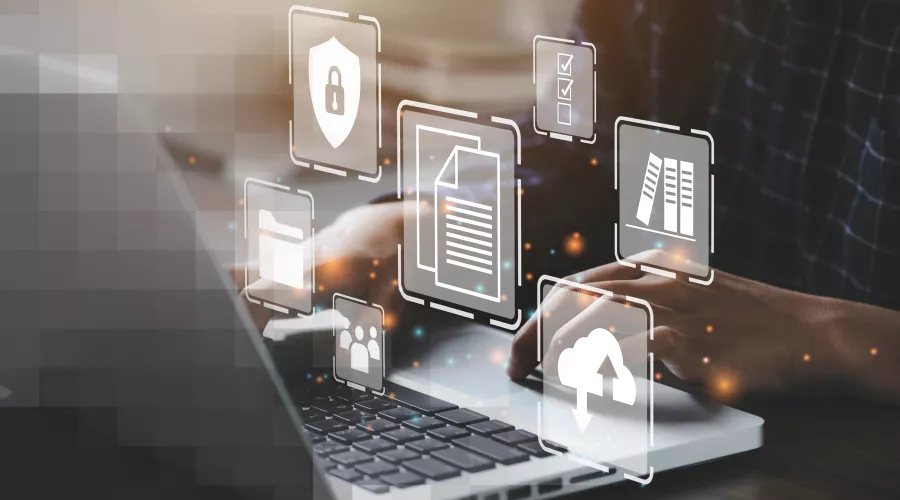

26.05.2025 | Blog AI in onboarding: How a digital assistant simplifies staff integration in public administration
Fast, direct, digital: the new demand for access to knowledge
The everyday use of applications such as ChatGPT & Co is also raising expectations of modern information retrieval technologies in the professional environment. Many employees - especially younger ones - have long been routinely using generative AI to access information quickly and easily. Instead of long manuals or sets of rules, they prefer compact, easily accessible content. In the private sphere, they naturally resort to chatbots or short YouTube explanatory videos instead of trawling through a long instruction manual.
AI provides answers to relevant administrative knowledge
In a professional context, an ideal counterpart would be an AI assistant provided by the employer to whom (new) employees can address their questions and who provides them with short, reliable answers - supplemented by references to suitable sources for further information. The necessary knowledge is quickly accessible; it is easier for junior employees to get up to speed more easily, benefiting the organization in return.
This is because organizational knowledge and process knowledge that employees need for their work is distributed across various internal sources such as drives, wikis, intranet and databases. On the other hand, there are also external data sources and information portals on relevant regulations and laws.
As a new employee, you first need to know that certain information even exists, where it is located and whether it is up to date. And then you may have to read for a long time to finally find the information you are looking for. You also have to rely on the support and commitment of your colleagues to pass on knowledge.
The iAssistant as a digital pilot in everyday public authority life
An AI-supported onboarding assistant such as the iAssistant plays a key role in making it easier for new employees to get to grips with day-to-day work at public authorities. If a public authority implements such an assistant, it is always available to new employees, answers questions about internal procedures or official workflows and provides targeted references to further information - e.g. in administrative regulations, internal manuals or relevant laws and ordinances. Instead of having to struggle through various documents, new employees receive targeted, contextualized information - in a compact format, easy to understand and with references for further reading. They can also ask questions about the documents they find and receive step-by-step guidance via chat to reach the information they need.
This creates low-threshold access to administrative knowledge that often takes weeks or months to acquire in the normal onboarding process.
Multilingualism and knowledge retention as plus points
Another advantage is that AI can work in multiple languages. Especially in public authorities with international teams or in cross-border administrative settings, this function helps to break down language barriers and find your way around more quickly. At the same time, the assistant serves as a digital knowledge repository by securing the expertise of long-standing employees - for example in the form of collected, possibly even curated or evaluated answers to frequently asked questions or structured access options to existing specialized information. This means that valuable expertise remains usable even after experienced colleagues have left the company.
Advantages for HR managers and organizations
In everyday life, the assistant answers typical questions such as:
‘How do I apply for teleworking?’ - ‘What do I need to consider when advertising a job online?’ - ‘How do I send documents internally that cannot be sent by post?’ - ‘Where can I find the holiday application or a business trip form?’ - ‘For which occasions can I take special leave?’ ‘Which regulation applies to procedure X?’ - ’Who is responsible for subject Y?’
Instead of relying on colleagues to answer their questions, new employees can find answers themselves - directly, comprehensibly and tailored to the respective authority.
For HR managers, this means
- Less time spent on recurring questions
- More standardized induction despite staff changes or decentralized structures
- Greater independence and faster integration of new employees
- Contribution to securing and passing on knowledge within the organization
Conclusion: Digitalization as the key to future-proof onboarding
Particularly in the face of demographic change, a growing shortage of skilled labor and increasing staff turnover, digital tools like this are a pragmatic step toward efficiently imparting administrative knowledge - without overburdening the induction process or tying up additional resources. The use of an onboarding assistant can therefore not only make it easier to get started but also strengthen the efficiency and attractiveness of the administration as an employer in the long term.
Related articles

How government agencies benefit from Enterprise Search & AI
The author
Manuel Brunner

